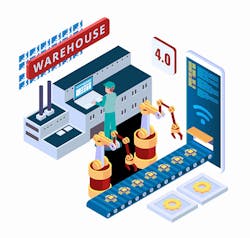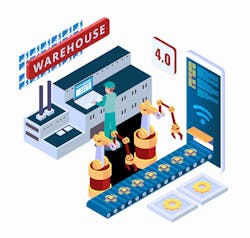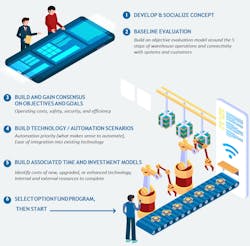In our “Industry 4.0 Series”, we’ve noted that “Industry 4.0 is a decade in the making yet is still out of reach for many manufacturing organizations.” This series of articles and webinar provides insight into the hurdles facing companies in implementing elements of IoT, outlines the six steps to Organizational Agility and Efficiency, and provides a Step-by-Step Guide for Implementing a 90-Day Roadmap to a Smart Factory.
Named because it is considered the Fourth Industrial Revolution, the Industry 4.0 concept is to capitalize on unique benefits that prior revolutions have created to date: technology, automation, artificial intelligence, the internet, and the capability to capture and process big data through data science. The practice is to bring these all together and people into a system of highly autonomous technologies that share real-time status and operating data with each other.
It’s important to recognize that Industry 4.0 is not just for manufacturing and production operations. It applies equally well to many other functional departments, like warehouse operations.
Warehousing operations are well suited to the application of 4.0 principles. It’s a closed physical space (microenvironment) with a defined function and plenty of automation and technology options to choose from in building the right model(s) for your business. We say models, plural, as consideration to large, multi- warehouse businesses whose sites may vary by size, product mix and geographic location, each employing a different version of the model. Through technology and plug-and-play automation, scalable instances are available.
WHAT IS WAREHOUSE 4.0? (W4.0)
The Internet of Things (IoT), big data and data science, augmented reality, wearables, computer vision, artificial intelligence (AI), low-cost sensors, cobots and high-level computing can be combined to build a robust system of warehouse automation; as a result, warehouses and distribution centers are becoming ‘smart,’ an essential component of the Integrated Supply Chain.
WAIT, I ALREADY HAVE A WMS, SO WHY WOULD I NEED MORE?
A Warehouse Management System (WMS) software is the fundamental building block for Warehouse 4.0, but not a total solution. Basic instances of a WMS, depending on its implementation, provide data on what has been received, where it is stored and what has been shipped; in other words, it is a data filing and processing system that can provide action recommendations.
A smart warehouse goes well beyond just WMS. Following the path laid down by your company’s ‘digitalization Roadmap,’ which will include some combination of the W4.0 description elements above, you can make significant progress toward automating business and operational processes and rules.
Managing the information details through data analytics and adding AI to make autonomous decisions and executing actions through its interconnected devices will enable your company to reduce costs and standardize operations on a global scale while achieving ultimate customer service and quality goals.
WAREHOUSE FUNCTION
The warehouse model you build can range from basic, upgrading the WMS with more elaborate storage management, including handhelds and forklift-based interactions to fully autonomous receiving, picking and packing systems in a ‘lights out’ operation.
Designing your particular program needs to recognize the purpose of a warehouse, simply, is to act as a buffer between:
- Suppliers and your business – supply chain strategy will determine sourcing, timing and quantity of materials to ensure target customer service levels
- Demand and manufacturing – the ultimate goal is JIT to minimize investments, but recent pandemic disruptions in supply chains have caused a rethinking of risk mitigation, so many companies have opted for maintaining some on-hand quantity to ensure an uninterrupted, more efficient manufacturing operation
- Manufacturing and customers – the warehouse function is to store and safeguard product for release (pick, pack, stage, ship) to customers as determined by the ERP operating under the business rules
WHERE TO BEGIN
Before beginning to build your Warehouse 4.0 program, it is critical to establish the baseline of your warehouse operations. Understand where your business is on the technology and automation spectrum and process and organization effectiveness and how well it is integrated with the rest of the business.
In most cases, a baseline evaluation model constructed around the fundamental warehouse operational steps provides a logical flow to rating the effectiveness of current technology used to enable each step and how efficiently each step is carried out:
- Receiving – capacity and resources planning for, and timing of, incoming materials to ensure synchronization with warehousing schedules and manufacturing needs, dock scheduling with appointments
- Stocking – the safe, speedy and efficient movement of materials to designated storage locations while minimizing travel and equipment use and recognizing specific quality requirements
- Storage – locations defined based on material specifications (dry, liquid, cold storage, fire and explosion hazards, etc.) along with appropriate racks, etc.
- Picking (Packing and Staging as well) – WMS provides clear material identification and picking instructions with minimal travel time, appropriate support equipment available, packing materials available and matched with labels, insert materials available as required, staging instructions provided
- Shipping – carrier and scale house coordination with dock scheduling and appointments
Building your Warehouse 4.0 program will require you to establish the goals of the program, which will be documented via a Digitalization Roadmap, which can include:
- Reducing warehousing operating costs – dock scheduling, demurrage and other drivers/carrier charges, damage, Lean organization to match resources to flow
- Increasing productivity – using automation, technology and Lean principles to eliminate waste like travel time, rework, over-handling, wait times, equipment conflicts
- Improving order quality – reducing order/ delivery change response times, picking errors, accurate packing and labeling
- Overall improved service levels – on time shipments, accurate and complete shipments, correct packaging, customer notifications of order status, customer service center response times, et al
Using your baseline and the established goals, the program team can build out various scenarios and determine costs and budgets. Due to the significant number of technology and automation options available, mapped to your current technology base, you will have various implementation options to choose from that will each have a different investment profile.
CHANGE IS WITHIN REACH
Wherever you are on a technology journey, there is always another step to take. Perhaps you are in the starting blocks, ready to embrace change. Perhaps you are much further along and ready to make investments in advanced elements of Warehouse 4.0. Either way, the end goals are largely the same. Done well, Warehouse 4.0 implementation that is right for you can generate a raft of data and insight to manage the business better and drive company competitiveness.
Change does not have to be a massive, radical, or revolutionary transformation to realize tangible and sizable benefits. Any good change management program comes in bite-sized, manageable stages. Rushing your people, who are instinctively reluctant in the face of change, will likely backfire and lead to a failed initiative. Today’s call to action is to take that first (or next) step – build a 90-day plan and accelerate your digital journey.
Six Steps to Warehouse 4.0 Implementation
ARE YOU READY TO TURN YOUR POTENTIAL INTO REALITY?
Feel free to call Barry Samria at (+1) 561-236-5745, or visit auderepartners.com to get started.



